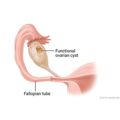Surgery for Ovarian Cysts
Surgery Overview
When an ovarian growth or cyst needs to be closely looked at, a surgeon can do so through a small incision using laparoscopy or through a larger abdominal incision (laparotomy). Either type of surgery can be used to diagnose problems such as ovarian cysts, adhesions, fibroids, and pelvic infection. But if there is any concern about cancer, you may have a laparotomy. It gives the best view of the abdominal organs and the female pelvic organs. Then, if the doctor finds ovarian cancer, he or she can safely remove it.
During surgery, a noncancerous cyst that is causing symptoms can be removed (cystectomy), leaving the ovary intact. In some cases, the entire ovary or both ovaries are removed, particularly when cancer is found.
What To Expect
General anesthesia usually is used during surgery.
After a laparoscopy, you can resume normal activities within a day. But you should avoid strenuous activity or exercise for about a week.
After a laparotomy, you may stay in the hospital from 2 to 4 days and return to your usual activities in 4 to 6 weeks.
Why It Is Done
Surgery is used to confirm the diagnosis of an ovarian cyst, remove a cyst that is causing symptoms, and rule out ovarian cancer.
Surgery for an ovarian cyst or growth may be advised in the following situations:
- Ovarian growths (masses) are present in both ovaries.
- An ovarian cyst that is being watched does not get smaller or go away in 2 to 3 months.
- An ultrasound exam suggests that a cyst is not a simple functional cyst.
- You have an ovarian growth and you:
- Have never had a menstrual period (for example, a young girl).
- Have been through menopause (postmenopausal woman).
- Use birth control pills (unless you are using low-dose progestin-only pills or have missed a pill, which would make an ovulation-related functional cyst more likely).
- Your doctor is concerned that ovarian cancer may be present. In this case, it is also advised that you see a gynecologic oncologist.
How Well It Works
An ovarian cyst can be removed from an ovary (cystectomy), preserving the ovary and your fertility. But it is possible for a new cyst to form on the same or opposite ovary after a cystectomy. New cysts can only be completely prevented by removing the ovaries (oophorectomy).
Risks
Risks of ovarian surgery include the following:
- Ovarian cysts may come back after a cystectomy.
- Pain may not be controlled.
- Scar tissue (adhesions) may form at the surgical site, on the ovaries or fallopian tubes, or in the pelvis.
- Infection may develop.
- The bowel or bladder may be damaged during surgery.
What To Think About
Surgery may be recommended if you have a large cyst, cysts in both ovaries, or other characteristics that may suggest ovarian cancer. Ovarian cancer can occur in women of all ages, but the incidence increases after menopause.
Credits
Current as of: February 19, 2019
Author: Healthwise Staff
Medical Review:Sarah A. Marshall, MD – Family Medicine & Martin J. Gabica, MD – Family Medicine & Kathleen Romito, MD – Family Medicine & Kirtly Jones, MD – Obstetrics and Gynecology, Reproductive Endocrinology
Current as of: February 19, 2019
Author: Healthwise Staff
Medical Review:Sarah A. Marshall, MD – Family Medicine & Martin J. Gabica, MD – Family Medicine & Kathleen Romito, MD – Family Medicine & Kirtly Jones, MD – Obstetrics and Gynecology, Reproductive Endocrinology
This information does not replace the advice of a doctor. Healthwise, Incorporated, disclaims any warranty or liability for your use of this information. Your use of this information means that you agree to the Terms of Use. Learn how we develop our content.




